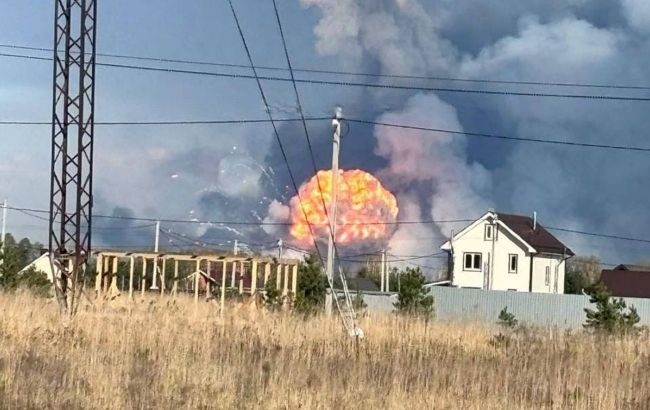Explosions at Russian missile arsenal: What happened at one of largest depots near Moscow?
 Photo: explosion at an ammunition depot in Russia (video screenshot)
Photo: explosion at an ammunition depot in Russia (video screenshot)
One of the largest ammunition depots of the Russian army detonated less than 100 km from Moscow. On April 22, explosions were heard at a military facility in the Vladimir region, followed by a fire. Evacuations were announced in nearby settlements.
RBC-Ukraine has gathered all the details known about the explosions at the military depot in Russia and the types of weaponry stored there.
Takeaways
-
Where did the explosion occur in Russia and what were its consequences?
-
What ammunition was stored at the depot in the Vladimir region?
-
What might have caused the detonation of the ammunition?
-
Why is the 51st Main Missile and Artillery Directorate's arsenal considered a complex target?
Explosions in the Vladimir region
On Tuesday, April 22, loud explosions were heard in the Kirzhach district of the Vladimir region, near the village of Barsovo. The military unit 11785 and the 51st arsenal of the Main Missile and Artillery Directorate (GRAU) of the Russian Ministry of Defense are located near this settlement.
The explosions were accompanied by a massive fire and a series of subsequent detonations, which were heard and seen in several villages in the region. Local residents recorded videos of a huge cloud of smoke resembling a giant mushroom.
Shortly afterward, the Governor of the Vladimir region, Alexandr Andreev, confirmed the explosion, noting that emergency services were working at the site. An emergency situation regime was introduced in the district.
Russian social media channels reported that the road to Kirzhach from Moscow was closed today. An evacuation was also announced for seven nearby settlements located close to the epicenter of the explosions.
According to reports from Telegram channels, during secondary detonations, two missiles flew out from the depot, one of which hit a private cottage, while the other fell in the town of Kirzhach near a leisure center. A resident of one of the villages was injured by a mine-explosive trauma caused by the detonating munitions.
It is worth noting that the village of Barsovo is located 8 km from the town of Kirzhach in the Vladimir region, and the straight-line distance to Moscow is 97 km. The distance from the explosion site to the border with Ukraine is approximately 530 km.

Screenshot of google.com/maps
Possible causes of the explosion at the GRAU arsenal
The Russian Ministry of Defense cited "violation of safety requirements" as the cause of the explosions in Barsovo.
According to the Russian military department, the detonation of munitions occurred after a fire broke out due to violations of safety rules when handling explosive materials.
A special commission will be created to investigate the incident. The Russian Ministry of Defense also emphasized that no one was injured as a result of the explosions.
Photo: explosions of ammunition in the Vladimir region of Russia (video screenshots)
However, residents of the area where the military unit and arsenal are located reported hearing drone sounds before the explosions, and some Russian Telegram channels speculated about a Ukrainian sabotage operation. Moreover, Russian media had previously reported a drone attack on this arsenal a month earlier. Last year, an evacuation was also declared in Barsovo due to a drone attack.
As of now, Ukrainian authorities have not officially commented on the events in the Vladimir region of Russia.
What is known about the GRAU military depot
The 51st Arsenal of the Main Missile and Artillery Directorate (GRAU) is a strategically important facility, covering an area of about 3.5 square kilometers.
According to the specialized publication Defense Express, the military depot where the explosions took place housed 45 separate storage units and 30 ammunition storage sites. Its design capacity is up to 264,000 tons of various munitions.
Like other GRAU arsenals, this depot is not specialized and is intended for the storage of a full range of ammunition – from artillery shells and missiles to anti-tank missile systems, surface-to-air and ballistic missiles, as well as missiles for operational-tactical complexes.
According to Militarnyi, the site contains both fortified bunkers for storing munitions and open storage areas for loading weapons. The latter are vulnerable to airstrikes, such as by drones, and could have caused a chain reaction of detonation.
Additionally, the 51st arsenal housed a laboratory that monitored the condition of powders and explosives used in artillery ammunition, as well as workshops with control and testing equipment for high-tech weapon systems.
Photo: 51st Arsenal of the GRAU (militarnyi.com)
Head of the Center for Countering Disinformation (CCD) of the National Security and Defense Council of Ukraine, Andriy Kovalenko, notes that the site contained large stockpiles of artillery shells and various types of missiles, including Iskander, Tochka-U, Kinzhal, as well as munitions for Pantsir-S1, S-300, S-400, and multiple launch rocket systems such as Grad, Smerch, and Uragan. In total, the arsenal held approximately 105,000 tons of weaponry.
According to Defense Express estimates, the strike on the 51st GRAU arsenal can objectively be regarded as the most challenging, as the site was heavily protected by Russian air defense systems.
"At the same time, Russia did not issue any alerts regarding potential strikes by Ukrainian drones or missiles. This means either other means were used, or Russia’s air defense system failed to detect the attack," the analyst concluded.
Sources: materials from Militarnyi, Defense Express, Meduza, and a post by the head of the CCD, Andriy Kovalenko.

